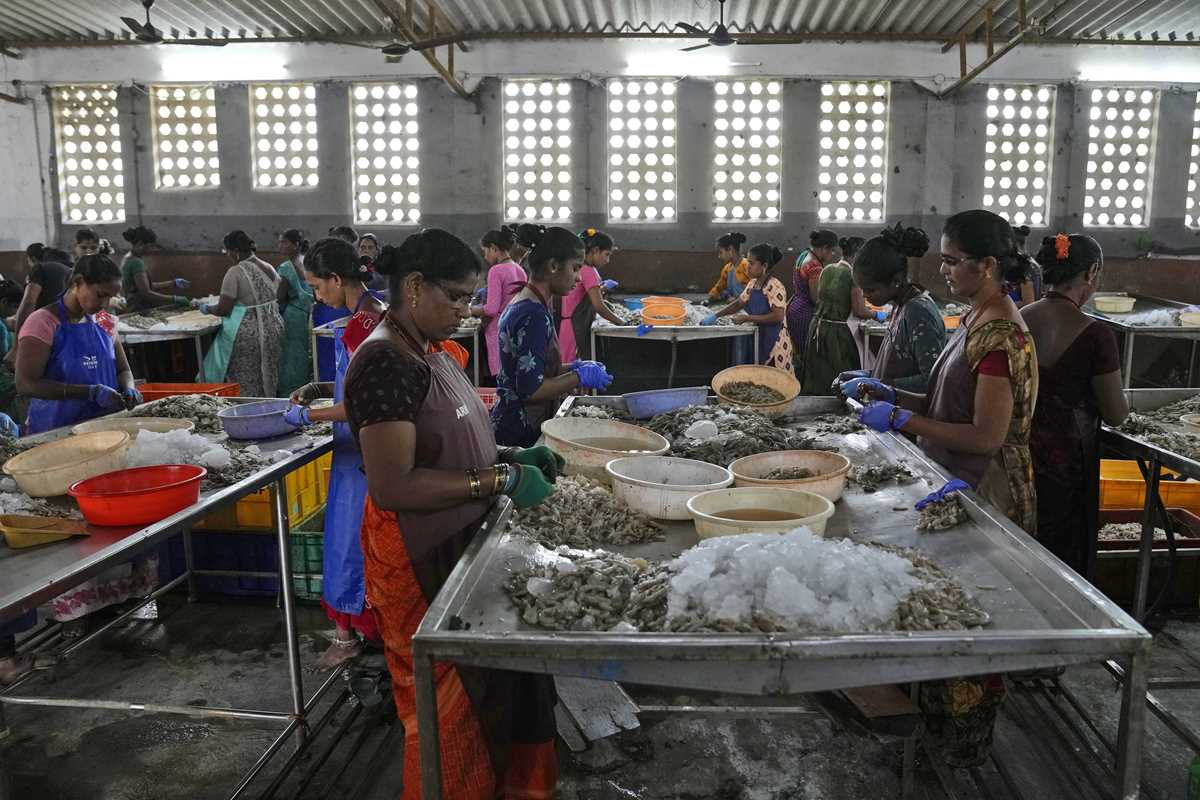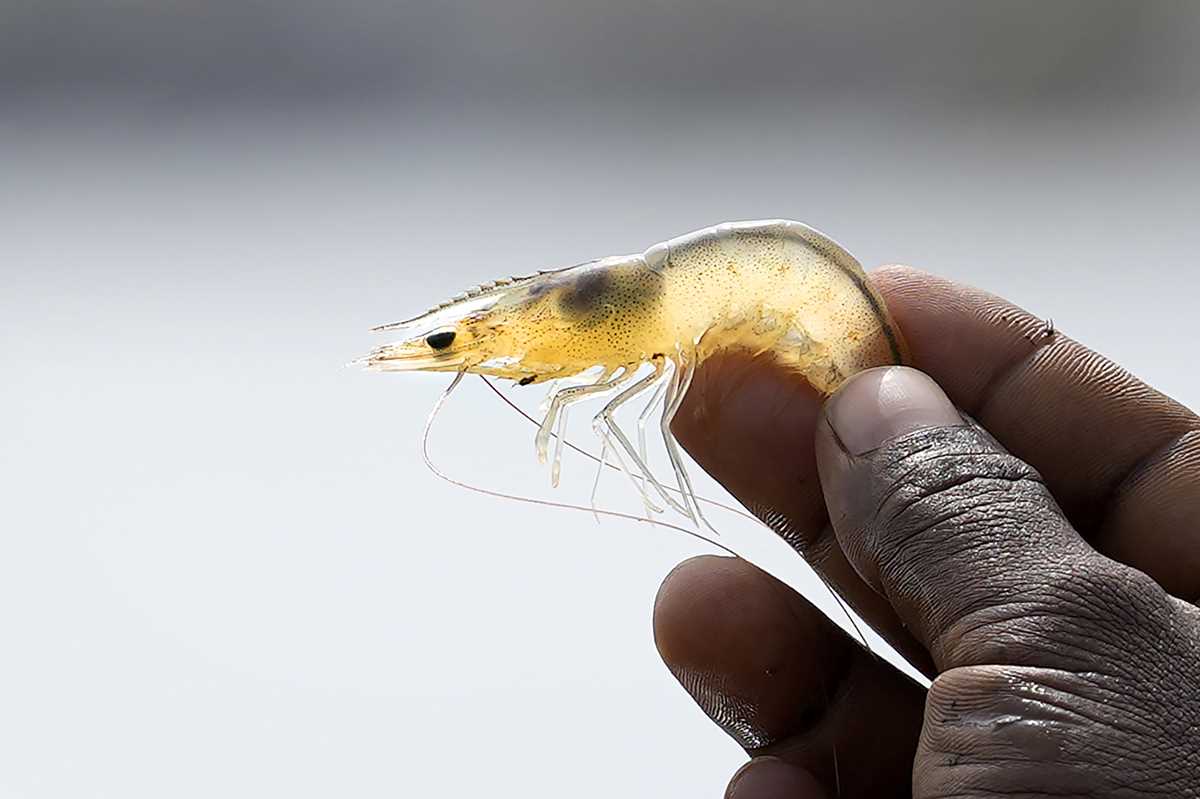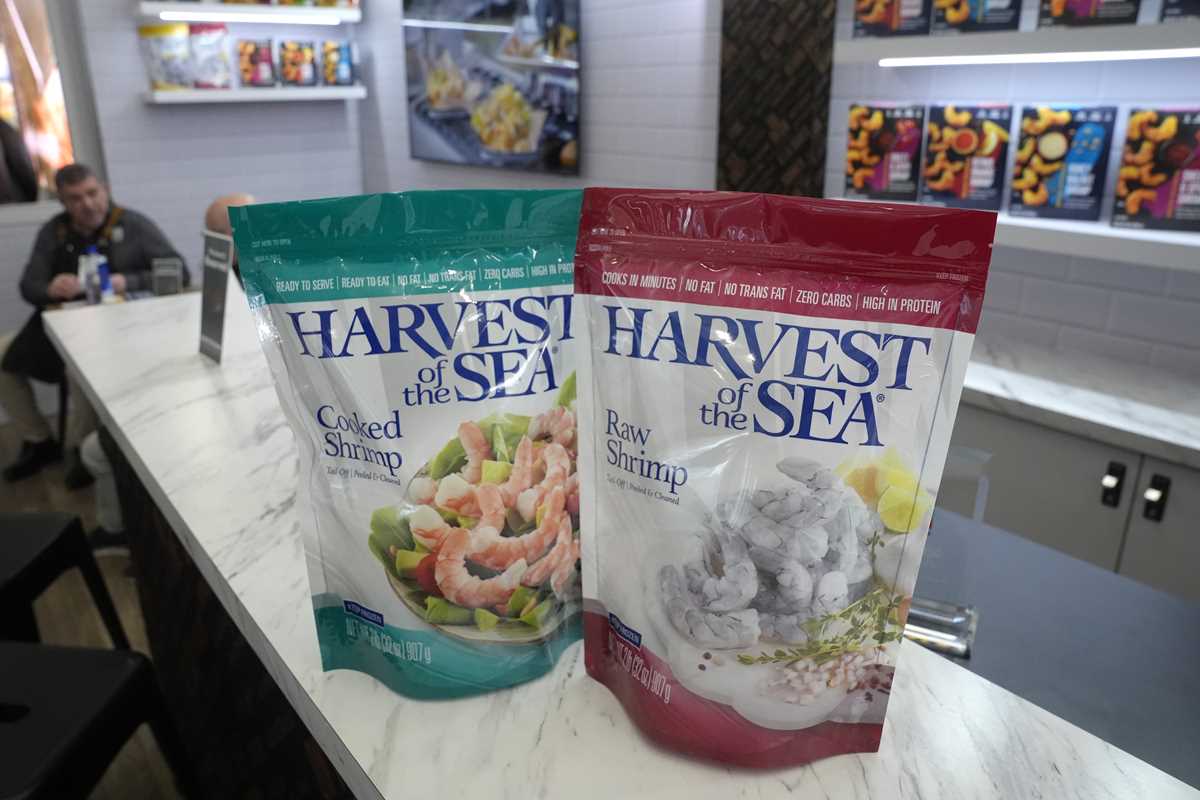 Workers peel shrimp in a tin-roofed processing shed in the hamlet of the Tallarevu, in Kakinada district, in the Indian state of Andhra Pradesh, Sunday, Feb. 11, 2024. Indian shrimp is regularly sold in major U.S. stores such as Walmart, Target and Sam’s Club and supermarkets like Kroger, Safeway and Sprouts. (AP Photo/Mahesh Kumar A.)
Workers peel shrimp in a tin-roofed processing shed in the hamlet of the Tallarevu, in Kakinada district, in the Indian state of Andhra Pradesh, Sunday, Feb. 11, 2024. Indian shrimp is regularly sold in major U.S. stores such as Walmart, Target and Sam’s Club and supermarkets like Kroger, Safeway and Sprouts. (AP Photo/Mahesh Kumar A.) A worker performs a routine check of shrimp at a hatchery in Nagulapally village, Uppada, Kakinada district, Andhra Pradesh, India, Saturday, Feb. 10, 2024. (AP Photo/Mahesh Kumar A.)
A worker performs a routine check of shrimp at a hatchery in Nagulapally village, Uppada, Kakinada district, Andhra Pradesh, India, Saturday, Feb. 10, 2024. (AP Photo/Mahesh Kumar A.) Harvest of the Sea shrimp packets are displayed on a counter at a Harvest of the Sea exhibit booth at the North American Seafood Expo, Monday, March 11, 2024, in Boston. Shrimp pulled from ponds alongside a busy highway in India were loaded into Wellcome KingWhite branded trucks. In the past year, Wellcome KingWhite has exported shrimp to several U.S. companies including Harvest of the Sea. (AP Photo/Steven Senne)
Harvest of the Sea shrimp packets are displayed on a counter at a Harvest of the Sea exhibit booth at the North American Seafood Expo, Monday, March 11, 2024, in Boston. Shrimp pulled from ponds alongside a busy highway in India were loaded into Wellcome KingWhite branded trucks. In the past year, Wellcome KingWhite has exported shrimp to several U.S. companies including Harvest of the Sea. (AP Photo/Steven Senne) Signs displaying shrimp appear on an exhibit booth, left, for CenSea, a frozen seafood importer, at the North American Seafood Expo, Monday, March 11, 2024, in Boston. U.S. trade records show the Indian company Nekkanti Sea Foods shipped 726 U.S. tons of farmed shrimp from India to the U.S. in the past year, to major American seafood distributors including AJC International Inc., Eastern Fish, CenSea, Jetro Cash & Carry Enterprises, King & Prince Seafood, Red Chamber Co. and Rich Products Corp. Those companies, in turn, sell Indian shrimp under popular brand names including Costar, Good & Gather, Great Value and Mrs. Friday’s at supermarkets, box stores and restaurants across the U.S. (AP Photo/Steven Senne)
Signs displaying shrimp appear on an exhibit booth, left, for CenSea, a frozen seafood importer, at the North American Seafood Expo, Monday, March 11, 2024, in Boston. U.S. trade records show the Indian company Nekkanti Sea Foods shipped 726 U.S. tons of farmed shrimp from India to the U.S. in the past year, to major American seafood distributors including AJC International Inc., Eastern Fish, CenSea, Jetro Cash & Carry Enterprises, King & Prince Seafood, Red Chamber Co. and Rich Products Corp. Those companies, in turn, sell Indian shrimp under popular brand names including Costar, Good & Gather, Great Value and Mrs. Friday’s at supermarkets, box stores and restaurants across the U.S. (AP Photo/Steven Senne)SAN FRANCISCO (AP) — India is the top supplier of shrimp to the U.S., with Indian shrimp stocked in freezers at most of the nation’s biggest grocery store and restaurant chains.
One reason for that is the low cost for consumers of shrimp from India. But that low cost comes at a price.
The Associated Press traveled in February to the state of Andhra Pradesh in southeast India to document working conditions in the booming industry, after obtaining an advance copy of an investigation released Wednesday by the Chicago-based Corporate Accountability Lab, a human rights legal group, that found workers face “dangerous and abusive conditions.”
Here are highlights from the AP’s reporting and the CAL report:
THE U.S. DEMAND FOR SHRIMPAmericans eat more than 5 pounds of shrimp per person per year, making it the leading seafood consumed in the country. Most American consumers would rather buy U.S.-produced food. But with only 5% of shrimp sold in the country caught in the U.S., local shrimp can be harder to locate and considerably more costly.
In the 1970s, the U.S. led the world in shrimp production. Then, shrimp was considered a delicacy. Diners were served expensive shrimp cocktails with less than a dozen shellfish. Over the next two decades, the use of inexpensive shrimp-farming technologies soared in Asia, and imports flooded the market.
India became America’s leading shrimp supplier in part because media reports including an AP investigation exposed modern day slavery in the Thai seafood industry. AP’s 2015 reporting led to the freedom of some 2,000 enslaved fishermen and prompted calls for bans of Thai shrimp, which had been dominating the market.
Today, Indian shrimp accounts for about 40% of the shrimp consumed in the U.S.
WORKING CONDITIONS IN INDIAIn Andhra Pradesh, AP journalists obtained access to shrimp hatcheries, growing ponds, peeling sheds and warehouses. AP journalists interviewed workers, supervisors and union organizers.
Residents said newly dug hatcheries and ponds had contaminated neighboring communities’ water and soil, making it nearly impossible to grow crops, especially rice they depend on for food.
From the ponds, trucks hauled the shrimp to peeling sheds. In one shed, dozens of women, some barefoot, stood on narrow wooden benches enduring 10-hour shifts peeling shrimp covered in crushed ice. Barehanded or wearing filthy, torn gloves, the women twisted off the heads, pulled off the legs and pried off the shells, making it possible for American cooks to just tear open a bag and toss them in a skillet.
Some workers said they pay recruiters about 25 cents a day out of their salaries just to set foot inside the processing shed. Transportation in company buses is also deducted from some workers’ salaries, along with the cost of lunch from company canteens. Many workers have no contracts, and no recourse if they are hurt on the job.
Many people in India struggle to survive amid endemic poverty, debt and unemployment. The women AP spoke with said this work, despite the oppressive conditions, is their only chance to avoid starvation.
WHAT DO BUSINESSES SAY?From India, the shrimp travels by the ton, frozen in shipping containers, to the U.S., more than 8,000 miles away.
It is nearly impossible to tell where a specific shrimp ends up, and whether a U.S.-bound shipment has a connection to abusive labor practices. And Indian shrimp is regularly sold in major U.S. stores such as Walmart, Target and Sam’s Club and supermarkets like Kroger and Safeway.
The major corporations that responded to AP’s queries said they deplore human rights violations and environmental damage and would investigate.
POSSIBLE SOLUTIONSHuman rights advocates say cost-cutting from U.S. supermarkets, restaurants and wholesalers squeeze producers to provide cheaper shrimp without addressing labor and environmental conditions.
CAL says Indian companies need to pay living wages and abide by labor, health, safety and environmental laws. In addition, the organization says U.S. companies need to ensure that the price they pay for shrimp is enough for Indian exporters to treat workers equitably. And, they say, both the Indian and U.S. governments need to enforce existing laws.
Ecologist Marla Valentine, who heads non-profit Oceana’s illegal fishing and transparency campaign, said consumers can help.
“You can use your dollar to make a difference,” she said. “When this isn’t a lucrative business anymore, it will stop.”
—
Mendoza reported from San Francisco and Boston. Kumar and Nagpal reported from Kakinada, India.
—
This story was supported by funding from the Walton Family Foundation. The AP is solely responsible for all content.
__
Contact AP’s global investigative team at Investigative@ap.org or https://www.ap.org/tips/
Before you make your next trade, you'll want to hear this.
MarketBeat keeps track of Wall Street's top-rated and best performing research analysts and the stocks they recommend to their clients on a daily basis.
Our team has identified the five stocks that top analysts are quietly whispering to their clients to buy now before the broader market catches on... and none of the big name stocks were on the list.
They believe these five stocks are the five best companies for investors to buy now...
See The Five Stocks Here
Wondering when you'll finally be able to invest in SpaceX, StarLink, or The Boring Company? Click the link below to learn when Elon Musk will let these companies finally IPO.
Get This Free Report